
A guide to corporate training and leadership development programs in 2023
Deloitte predicts that more than 50% of employees will require reskilling and upskilling in the next 3 years. SHRM suggests that HR professionals are already facing a shortage of skills during recruitment.
Over the past decade, the global workforce is evolving continually due to factors like:
- Digital revolution
- Competitive business landscape
- Rising complexity
These are resulting in reshaping the future of employees. The shift means that having a vibrant workplace which is aligned to a knowledge based economy is a must. Infact, a significant percentage of market capitalisation is based on intangible assets now~skilled employees and exceptional leaders.
In this landscape, the time to invest in employee training and development would be…RIGHT NOW. Having said that, most organisations are already offering tons of training programs for their employees. Yet they are unable to make the impact they hope they can. Either employees don’t connect with the materials or they fail to apply the knowledge to their job roles. This is why organisations are unable to see the real impact.
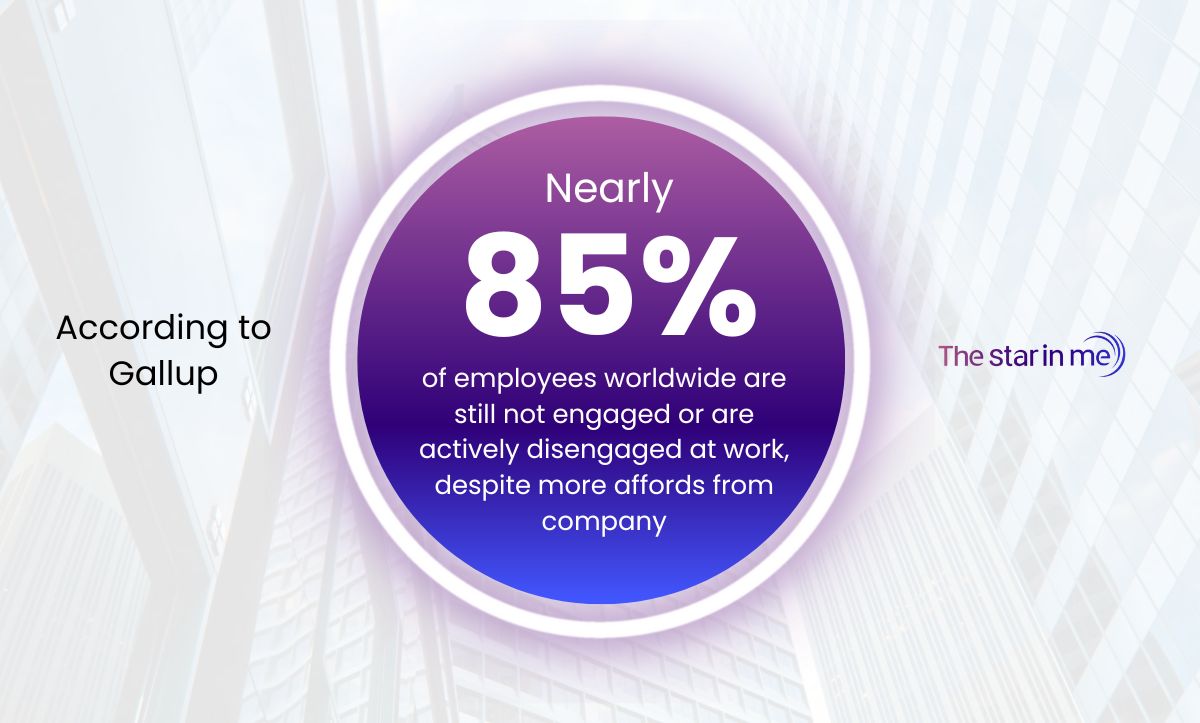
Organisations need to reexamine business strategies, workforce models, values, and culture to stay aligned with the new demands from employees and marketplaces. Also, the need for effective corporate training and leadership development training programs is increasing with employees valuing career development more than ever before.

In this article, we will share about different aspects of learning and development so that you can maximise the effectiveness of corporate training and leadership development programs in 2023 and beyond.
Let’s begin!
Section 1: Introduction to corporate training and leadership development programs
In simple terms, employee training and leadership development programs educate employees about the knowledge gaps, offer skill based education, and make them future-ready. But the way organisations offer this support might vary.
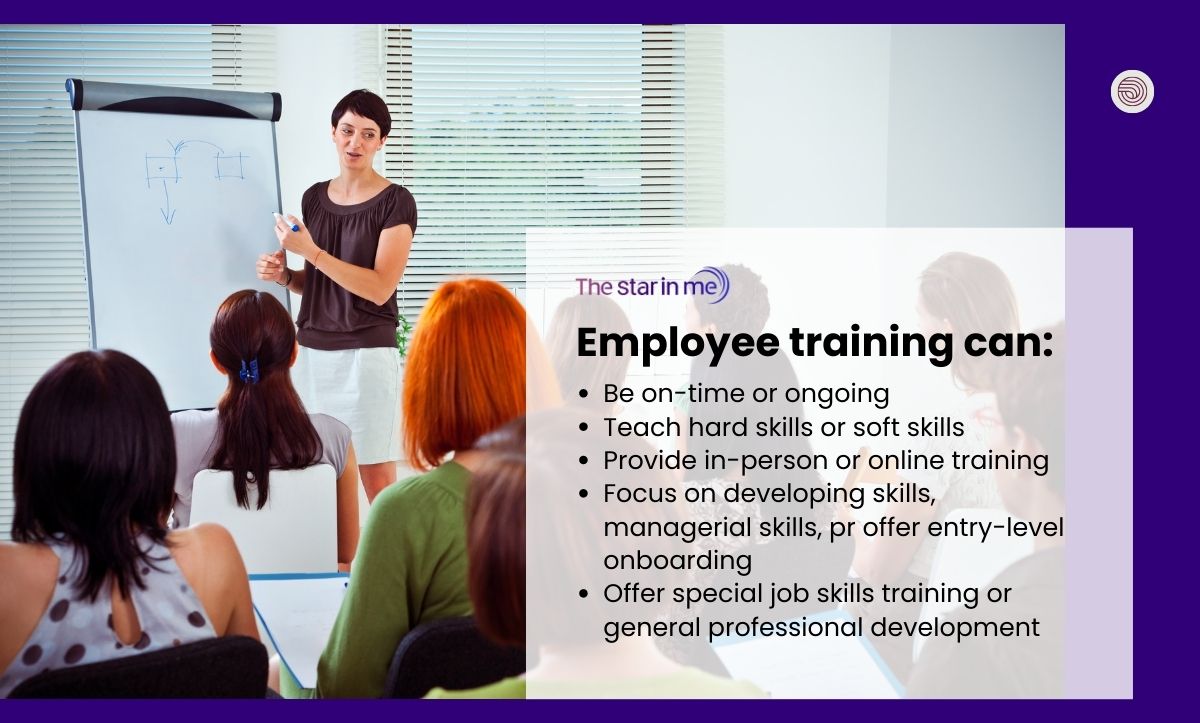
Source: KnowledgeCity Learning Solutions
But if you ask us, training and development is an ongoing process in which organisations offer knowledge and skill based resources to their employees so that they reach their full potential and optimum performance. In addition to that, it is much more than providing training only. In essence, it is about building a culture of continuous learning across all levels.
Today, especially given the pace of digital transformation and disruption, organisations need to be proactive about the skills to pursue the blue sky opportunities. In short, learning and development is about aligning employee goals and performance with that of your organisation’s.
We understand that it’s easy to say you have to invest in training and development of your workforce. But how to begin? How can you embrace transformation?
Here’s how!
#1 Understand the gaps and opportunities
The pandemic accelerated the adoption of new business models in addition to evolution in the needs for skills that weren’t a part of organisational culture a decade back. Learning and development won’t be about educating employees of what’s going within an organisation but it will allow employees to adapt to the change and empower employees to take up to-do lists: skilling, well-being, leadership, and DEI.
#Rethink HR disciplines
With Great Resignation, Quiet Quitting growing across the world, employee attrition is at an all time high. This is why learning and development can focus on the convergence of talent development, skill-based planning, and internal mobility to build a culture of continuous learning.
#Unlock drivers to success
Ideally the organisations must collaborate with HRs and stay close to stakeholders to build a program that makes sense across all levels. The ideal way is to activate your managers and listen to the learners. That way a culture of continuous learning won’t stop.
Besides that, learning and development is about building a culture. And when we talk about organisational culture, having opportunities to learn and grow is the number one factor that employees say define an exceptional work environment.
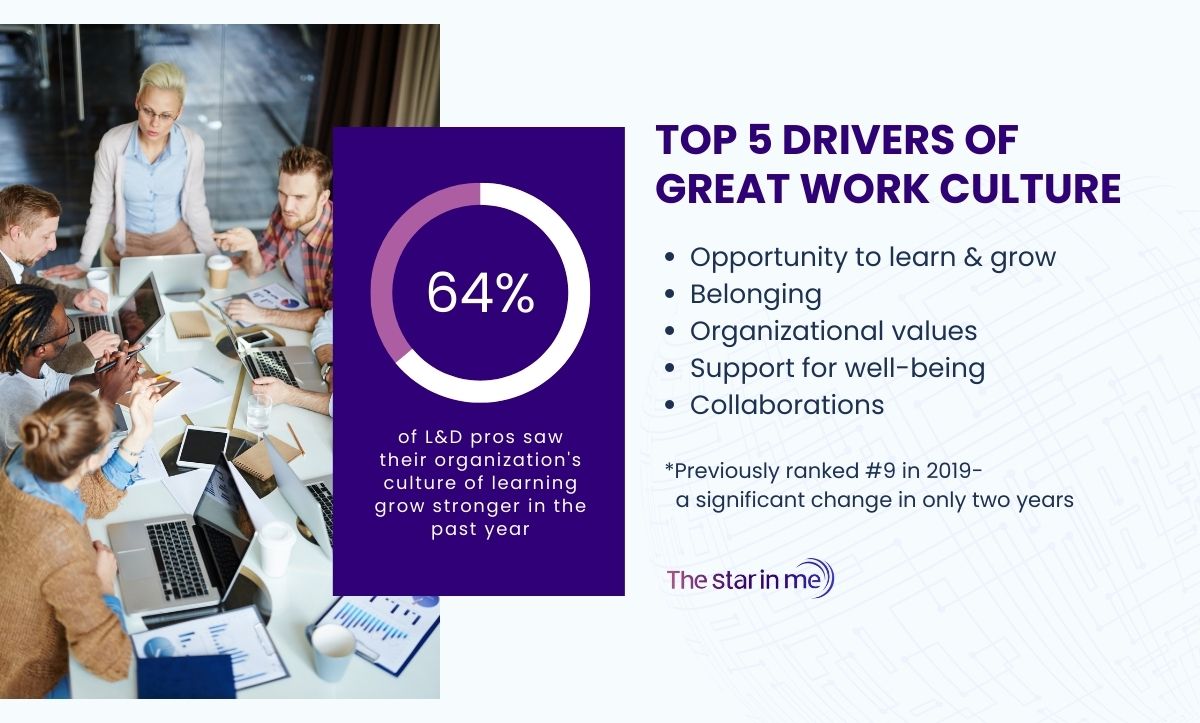
Since the world is undergoing a potential recession ahead, and skills shortages, there is pressure on organisations to revitalise people and talent strategies to meet the changing expectations. Let’s not get stuck with the terminologies now and move ahead to breaking down the types of corporate training and leadership development programs.
Section 2: Types of corporate training and leadership development programs
When companies are looking for new ways to shield themselves from the economic downturn, the first step is usually to start cost-cutting measures. And the result is mostly around lesser head count, hiring freezes, budget cuts in training, and more. However, HBR suggests it’s the employee training that takes a toll.
However, if you invest in learning and development opportunities, your current employees will gain confidence in the organisation and themselves to tide over the downturn. There are numerous ways that you can integrate corporate training and leadership development programs.
Here are different types of training programs that you can use to increase employee engagement and confidence in you as an organisation:
1. New employee onboarding and orientation:
Only 12% of employees feel that their company does a great job with onboarding. This is one of the processes where you allow new employees to get an understanding about the organisation, their structure, culture, vision, mission, and values. For some, it could be a day or two activity while for others it could span for many months. This training is a comprehensive process that makes a difference of how the new hire will do in terms of productivity, engagement, and success.
What to do:
This is the chance to make an amazing first impression. The training should help them get access to what they need early. The idea is to add culture, connection, clarification, and compliance along with collaboration into the training protocol. This will help them:
- Ask clarifying questions
- Learn problem solving tactics from peers
It will make other processes easier than ever before.
2. Technical training:
With technology evolving and changing rapidly, teaching employees how to use technology is a must. It will help them stay updated with the changes in the market. It could range from a quick one time course or more, depending on the outcomes required.
What to do:
Technical knowledge isn’t mandatory for everyone. Therefore, if it isn’t required to do a job well, never impose it. You must revisit the list who require this training yearly so that you don’t miss any valuable information. You must always measure the effectiveness of training using feedback, questionnaires, quizzes, and assessments so that you achieve the highest ROI on your training.
3. Leadership training:
It is one of the most common training programs that focuses on interpersonal abilities but the emphasis is mostly on leadership qualities and skills that directly influence leading others. While they are quite common, they are often overlooked by the organisations. However, its trickle down effect can cost you millions.
For example, a lousy manager can impact your employee retention, talent engagement, and other abilities. Having said that, let’s be clear that leadership development isn’t a replacement for corporate training or career coaching. It is a supplement which helps employees get access to resources that can help them understand the skills involved to lead with influence.
What to do:
Since the whole concept revolves around building foundational skills, it is quite the best offering for potential leaders or the ones in their leadership positions. Ideally, you must conduct 1:1 regularly to understand their vision, goals, and how it is aligned with your organisation’s vision. That way you will help your organisation to develop leaders that are instrumental in making your company, The Best Places to Work. For this to be effective, you must:
- Outline business goals.
- Identify the skill gaps.
- Use self assessment methods to find out training needs.
- Create your leadership roadmap.
4. Diversity and anti-bias training:
To make your organisation equitable and inclusive, your employees need to understand how to be respectful and compassionate towards others. It includes the necessary soft skills training that allows them to be an ally and report any harassment, in case of any. It is about educating different scenarios that might be impacting an employee’s potential to reach its threshold.
A lot of organisations use interactive quizzes, visual aids, knowledge checks, and assessment to make their workplace safe and psychologically safe.
What to do:
It should be mandatory during onboarding when you roll out the new courses. You must use an empathetic approach to make it a success. It should revolve around microaggressions and unconscious bias. You can share data or real life stories anonymously so that employees get an option of asynchronous learning. This will help them learn about the changes at their own pace.
Besides these, one can focus on training related to product, sales, and development programs across all levels so that employees get the opportunity to grow and move up the corporate ladder.
At the same time, if you want to find ideal/ potential participants for corporate training and leadership development programs, here’s a breakdown depending on their level or potential ability.
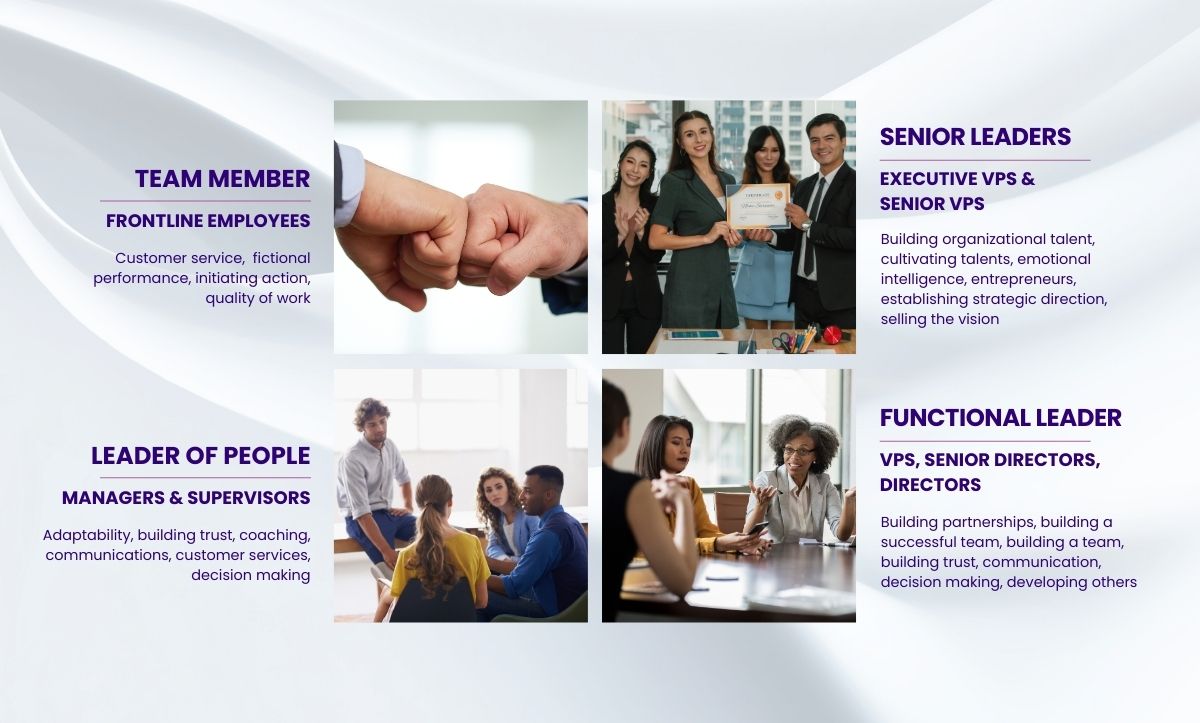
This is how the training and development applies to employees at different levels.
- Independent contributors: These are the employees who keep your business running on the ground. This is why keeping them motivated, productive, and invested is the most important element to make regular progress. You must equip these employees by providing them access to resources that will help them be individual contributors and prepare them to move into management roles.
- Give them the opportunity to attend events and sessions led by experts on certain skill sets.
- Coach them to gain knowledge about internal processes and methods.
- Managerial/ leadership roles: You must offer training sessions that will help these employees improve their tactical leadership capabilities. For instance, processes like “how to lead effective meetings, time management 101, project management 101, giving constructive feedback, and making difficult decisions.
At the same time, make sure you have the support system in place that allows them to smoothly transition from lower level executives to manager, C-suite, and leaders. Ideally, you must offer them L&D training and sessions where they can learn and grow. For examples,
- Cohorts to get together and build relationships and discuss their learnings.
- Coaching via coaches to guide employees about different aspects of being a good professional.
- Communications channels to turn to one another for advice.
Now that you are aware about the types of corporate training and leadership development programs, here are 3 common ways you can use them to deliver them to your employees.
- Online learning: This is the best go-to way for most businesses. More than 90% of organisations use e-learning as a part of their training module. It reduces training costs and gives organisations competitive advantage. And since it is globally accessible, you don’t have to disrupt your team’s workflow. This improves retention rates by 50% and performance by 25% since you give employees a chance to learn at their own pace.
- Instructor-led training: This can be done online or offline. It is a tried and tested method that allows employees to understand a concept from coaches without researching on their own. Since it is an easier to deliver and quite familiar approach, more than 50% of businesses use this approach. Also, humans love learning and easily grasp concepts when it’s collaborative and engaging.
- Blended learning: As the name suggests, it means the amalgamation of the two methods mentioned above. It’s about giving the best of both worlds. The face-to-face training engages employees while at the same time the online element allows them to learn at their own pace.
Once you get a hang about the type of corporate training and leadership development programs, here’s a detailed explanation of the process of training and development.

Section 3: The process of training and development
If you value employees, you probably have already started with the skills development in your workplace. However, a lot of times it gets squeezed around different other priorities. In fact, you won’t believe that 60% of employees spend less than an hour on learning per sitting. In the world of competing priorities, we need to offer courses or resources that don’t take much time but have a lot of impact.
Once you understand that, follow the process of corporate training and leadership development to gain maximum benefits. Here it goes:
- Identify the need of training and development program:
This is an important step before you roll out a training and development program. This gives you an idea about the specific need in your organisation. For example, the need could be about introduction of new skills or updating existing skills of employees. For seniors or C-suite, it could be about improving behavioural skills or to ensure teamwork within an organisation. Unless you identify the need, you must never move on to the next step.
Here’s how you can do it.
- Identify the needs at organisational level
- Identify the needs at department level
- Identify the needs at an individual level.
- Understanding the objectives of training and development
Once you understand the need, you can set various goals and objectives before implementing any corporate training and leadership program. Here are some goals that you can list down to begin your L&D programs and training.
- To impart skills: The goal here is to improve efficiency and reduce the amount of time wasted to do certain tasks.
- To educate: The idea here is to provide hands-on-experience of the task. The employees will get enough judgement skills to improve their reasoning around the concepts to do their tasks with utmost efficiency.
- To improve knowledge: The goal here is to improve behavioural knowledge of the employees so that they can enhance understanding of relations, management, and professional environment amongst employees.
- To improve ethical conduct: The idea is to help employees understand what’s ethical and what can cause a challenge going forward.
- To improve mindset: Human mind works in different ways. But to maximise the potential of your employees, you need to help them navigate through feelings, reactions, and beliefs. This will help them improve commitment and satisfaction by providing motivation.
- To improve corporate language proficiency: Corporate communication is an important aspect of a professional life and it changes across every level. This is why understanding the awareness of corporate culture and language proficiency can help manage different emergencies smoothly.
- Use the right training methods
Depending on the goals and objectives of your training and development program, here are some of the training methods that are often used in the corporate world:
- Orientations: These are usually used to introduce new employees to the work culture. It could include a few sessions, meetings with the manager. The idea is to make them aware about the work profile, goals, and objectives. This will give you a chance to introduce them to the policies, DEI initiatives, and resources that can help them stay on course with your company’s vision and goals.
- Lectures: This is usually a communication method where the important information is conveyed to the employees. This is usually helpful if there are a large number of employees.
- e-learning: In this you provide your employees a platform where they get access to study materials and they get to learn at their own pace.
- Instructor-led: This is quite a common way to improve knowledge of your employees around topics and challenges that will help them spark their career from one level to another.
There are other options that you can use like team building exercises, job rotations, role playing to make the employees aware of their skill gaps and prepare themselves to be future-ready.
- Implementation of the program
If you are implementing a specific skills program, you need to check the workload and available time so that the employees don’t feel pressured. For other training and programs, you can connect with the HR department and managers so that you can decide the time period of training and development programs.
Here’s how you can get started:
- Develop program content, training method, find the speakers/ trainers, mode of communication, and training aids.
- Prepare the material so that you can provide quality content and interactions.
- Evaluation of the program
Here you need to understand whether the programs are making an impact on the company’s bottom line. You can check in terms of productivity, accuracy to determine the success of the program. The implementation of the learning matters too if you want to evaluate the effectiveness of the plan.
Section 4: Characteristics of effective corporate training and development programs
When was the last time you took a good look at your training program? Last month, Last quarter, or Last year? Do you believe that it is effective? We believe that you understand that employee training is important for employees as well as your company. But for a better bottom line, you need to create effective employee training programs.
Remember, your employees dread training programs. They expect long boring sessions and perceive them as dreary college lectures. So, if you want to extract the maximum benefits, your corporate training and development programs must have the following characteristics.
- It should be aligned to business objectives: This is the most important aspect of a training program. The training must always be aligned to the organisation’s business objectives. Without that, you won’t be able to benefit. Instead, you might risk losing ground in the competitive market. This is why you must develop a program after assessing your current business objectives.
- Active engagement: Employees should be actively engaged in the learning process. This can be achieved through interactive learning methods, such as role-playing exercises, case studies, or group discussions.
- Customization: Training programs should be customised to meet the needs of individual learners or specific job roles. This can help employees to see the relevance and value of the training in their day-to-day work.
- Measurable outcomes: Effective training programs should have clear and measurable outcomes. This can include changes in employee behaviour or performance, improvements in productivity or quality, or increased employee satisfaction and engagement.
- Continuous improvement: Training programs should be regularly evaluated and updated to reflect changes in the business environment, emerging trends, and new technologies. This ensures that the training remains relevant and effective over time.
- Supportive learning culture: A supportive learning culture should be fostered in the workplace, where employees feel encouraged to learn and develop their skills. This can be achieved through leadership support, recognition of learning achievements, and opportunities for continuous learning and growth.
 Use tab like this but include content “ Connect with us to build a culture of continuous learning
Use tab like this but include content “ Connect with us to build a culture of continuous learning
Schedule a meeting
Section 5: The role of corporate training and leadership development in business success
Businesses can’t run on autopilot mode. You need people who will set the right direction, help you make smart decisions, and lead the way to achieve your goals and business bottom line. Corporate training and leadership development play a crucial role in driving business success. Here are some ways in which they contribute to an organisation’s performance:
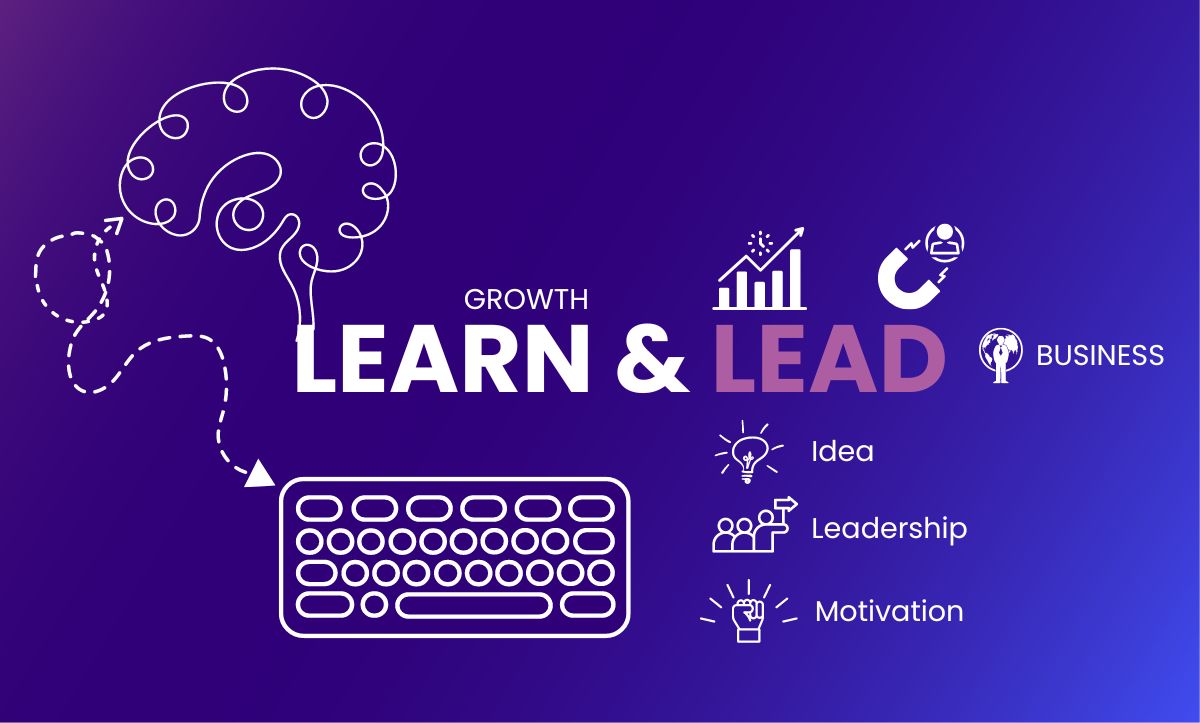
Source-eLearning Industry
- Enhanced employee skills and knowledge: Corporate training programs provide employees with the skills and knowledge they need to perform their jobs effectively. This can improve their productivity, quality of work, and customer satisfaction.
- Improved employee engagement and retention: Leadership development programs can help employees feel valued and invested in the company’s success. This can improve employee engagement and retention, leading to a more stable and committed workforce.
- Higher levels of innovation: Training and leadership development can foster a culture of innovation, where employees are encouraged to share ideas and take risks. This can lead to new and creative solutions that drive business growth.
- Stronger leadership and management: Leadership development programs can help managers and executives hone their leadership skills and make better decisions. This can lead to more effective teams, better communication, and improved collaboration.
- Increased competitiveness: By investing in training and leadership development, organisations can build a competitive advantage. They can attract and retain top talent, develop new products and services, and adapt to changing market conditions more quickly.
Overall, corporate training and leadership development are essential to building a skilled and engaged workforce, promoting innovation and growth, and achieving long-term business success.
Section 6: Case studies of successful corporate training and development programs
Here are a few case studies of successful corporate training and development programs:
- IBM’s “Think Academy”: IBM created its Think Academy program to provide employees with a one-stop-shop for all of their training needs. The program includes online courses, virtual classes, and in-person training sessions on a variety of topics, including technology, business, and leadership. Since its launch in 2010, the program has been a huge success, with over 2 million registered users and a 94% satisfaction rating.

- Amazon’s “Virtual Contact Center”: Amazon’s Virtual Contact Center program provides employees with the training they need to work in the company’s customer service department. The program includes both classroom and online training, as well as on-the-job training with a mentor. Since its launch in 2005, the program has trained thousands of employees, and has helped Amazon maintain its reputation for excellent customer service.

- Marriott’s “M-Learning”: Marriott’s M-Learning program provides employees with on-the-go training through their smartphones and tablets. The program includes courses on customer service, leadership, and management, and has been a huge success since its launch in 2013. In fact, the program has won several awards, including the Brandon Hall Gold Award for Excellence in Learning.
- Deloitte’s “Leadership Academy”: Deloitte’s Leadership Academy is an online platform that provides employees with access to training on a variety of topics, including leadership, strategy, and innovation. The program includes courses taught by experts in the field, as well as online forums where employees can share ideas and best practices. Since its launch in 2008, the program has been a huge success, with over 15,000 users and a 98% satisfaction rating.
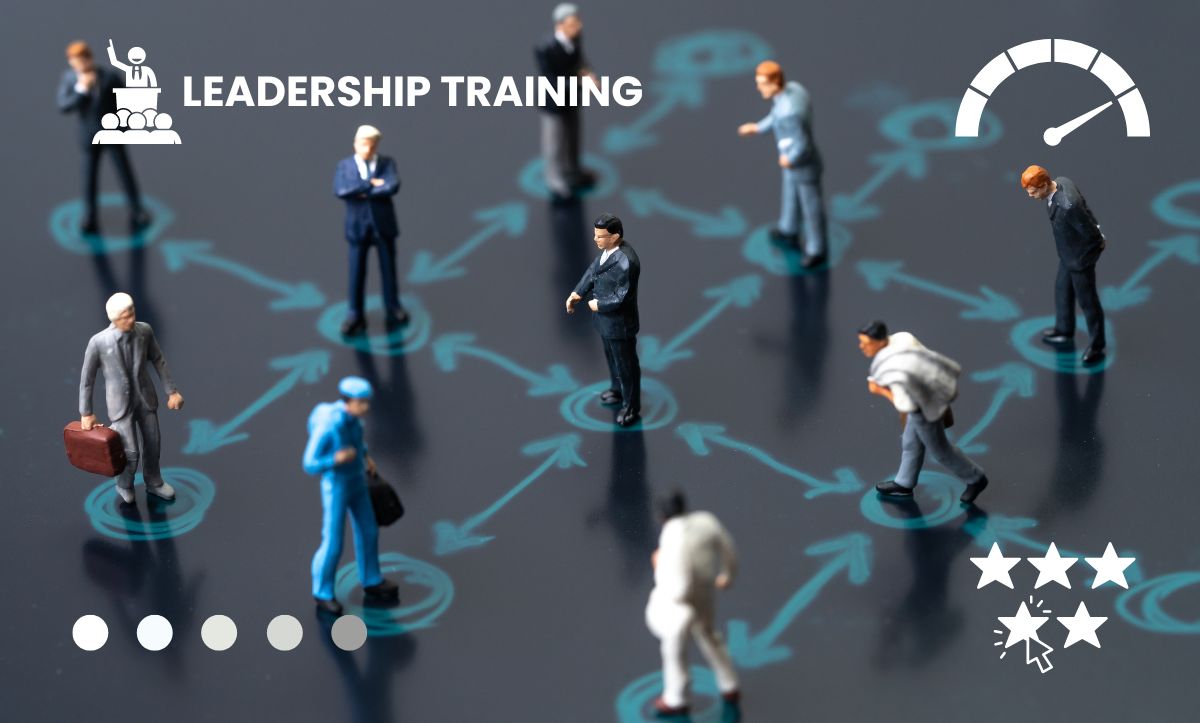
- AT&T’s “Future Ready”: AT&T’s Future Ready program provides employees with the training they need to stay up-to-date with the latest technology and trends. The program includes courses on topics such as coding, data analysis, and artificial intelligence, and has been a huge success since its launch in 2016. In fact, the program has been recognized by several organisations, including Training Magazine, which named it one of the top 125 training programs in the world.
Section 7: The financial benefits of investing in corporate training and development
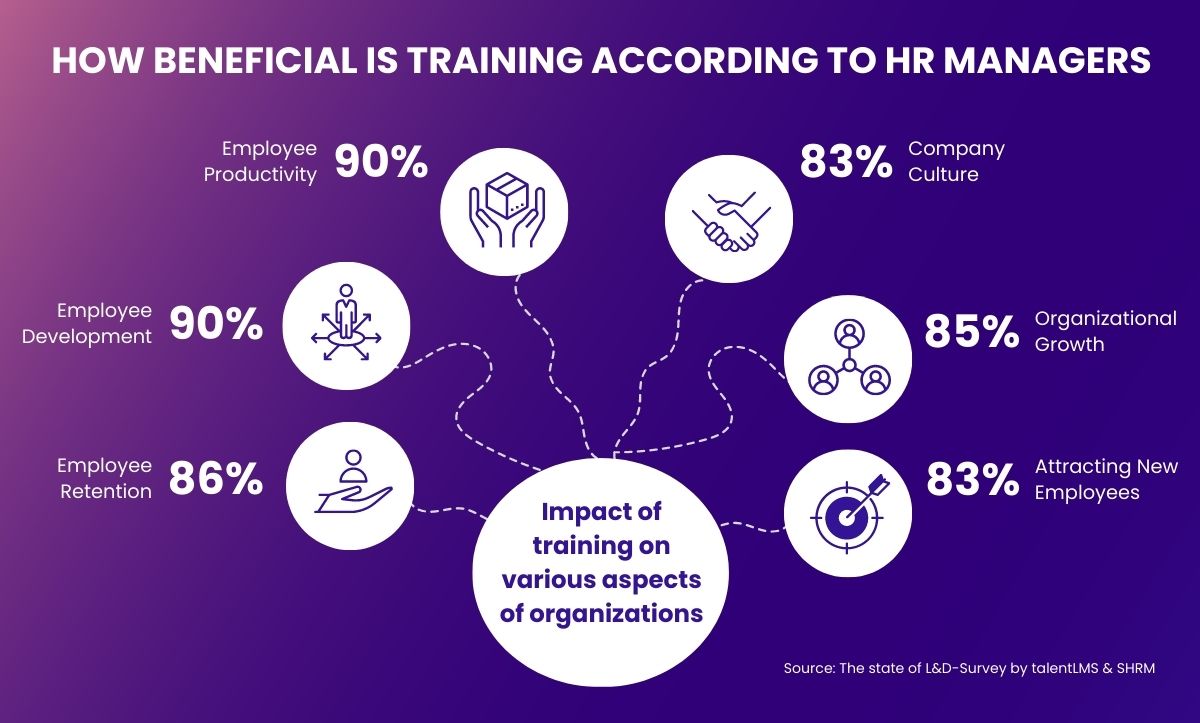
Investing in corporate training and development can yield significant financial benefits for businesses. Here are some of the key ways in which training and development can contribute to a company’s bottom line:
Increased productivity: Well-designed training programs can improve employee productivity, which can lead to greater output and revenue for the organisation.
- Reduced costs: Training programs can help reduce costs associated with employee turnover, absenteeism, and errors. Employees who receive training are also more likely to follow established procedures and adhere to quality standards, which can minimise the risk of costly mistakes.
- Improved customer satisfaction: Training programs can help employees deliver better customer service, leading to increased customer loyalty and repeat business. This can have a direct impact on revenue and profitability.
- Enhanced innovation: Training and development can foster a culture of innovation, where employees are encouraged to share ideas and take risks. This can lead to the development of new products and services that generate revenue and improve the company’s competitiveness.
- Higher employee retention: By investing in training and development, organisations can improve employee engagement and retention. This can help reduce the costs associated with recruiting and onboarding new employees.
- Improved financial performance: Research has shown that companies that invest in employee training and development tend to have better financial performance than those that do not. This can be attributed to the various benefits listed above.
In summary, investing in corporate training and development can have a positive impact on a company’s financial performance by improving productivity, reducing costs, increasing customer satisfaction, fostering innovation, improving employee retention, and enhancing overall performance.
If you don’t agree, here are some statistics and facts about the financial benefits of investing in corporate training and development:
1. According to a study by IBM, every dollar invested in online training results in $30 in productivity.
2. The Association for Talent Development (ATD) reports that organisations that offer comprehensive training programs have a 218% higher income per employee than companies that don’t.
3. A study by the Aberdeen Group found that companies that invest in employee training and development have a 24% higher profit margin than those that do not.
4. A report by the American Society for Training and Development (now ATD) found that companies that offer training and development programs have a 24% higher profit margin than those that spend less on training.
5. A study by Accenture found that companies that invest in training and development have a 16% higher market share than those that do not.
6. A report by the Brandon Hall Group found that organisations that invest in employee development and career advancement programs have a 34% higher employee retention rate.
These statistics demonstrate that investing in corporate training and development can lead to significant financial benefits, including increased productivity, higher profits, and improved employee retention.
By providing employees with the tools and resources they need to succeed, organisations can create a skilled and engaged workforce that drives business success.
Section 8: Steps for improving corporate training and development programs
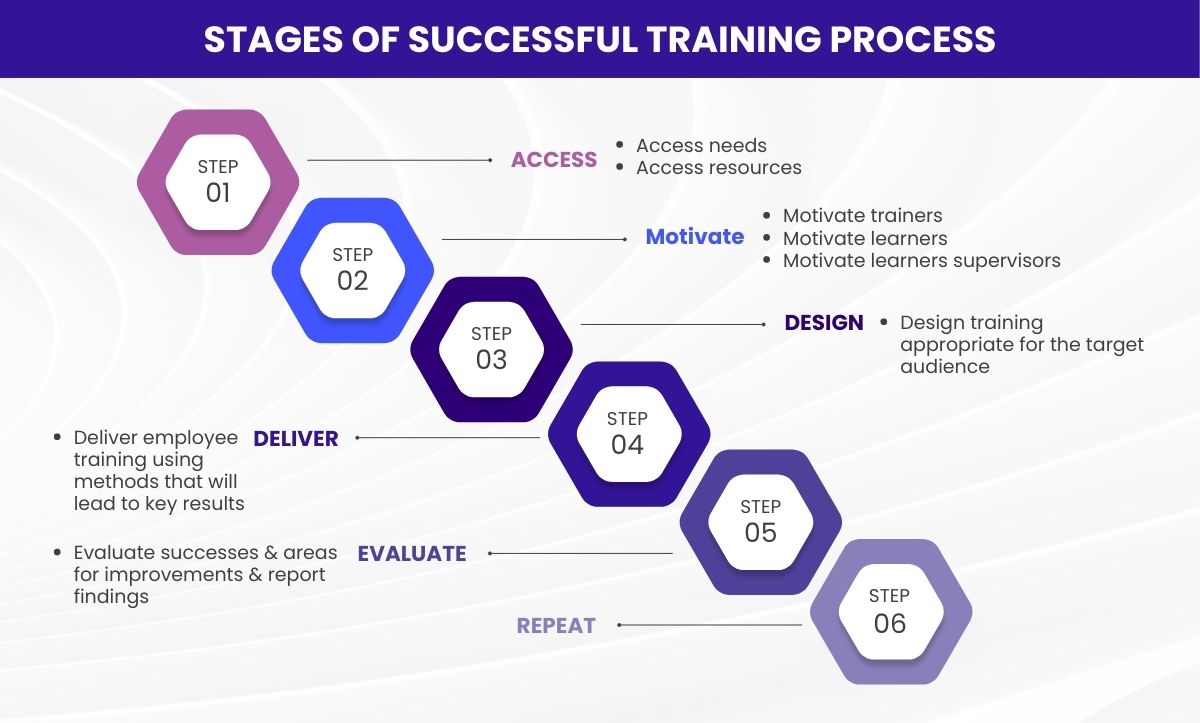
Source: Venngage
Here are some steps organisations can take to improve their corporate training and development programs:
- Conduct a needs analysis: Before developing or revamping a training program, it is important to identify the specific skills and knowledge gaps that exist within the organisation. A needs analysis can help determine which areas require training and what specific training topics should be covered.
- Set clear goals and objectives: Establishing clear goals and objectives for a training program can help ensure that it aligns with the organisation’s strategic priorities. It can also help trainers and learners understand what they are expected to achieve from the program.
- Use a variety of training methods: Effective training programs use a variety of methods to accommodate different learning styles and preferences. This can include e-learning modules, in-person workshops, coaching and mentoring, and on-the-job training.
- Engage learners: Engaging learners throughout the training process can help improve retention and application of new skills and knowledge. This can be done by providing interactive and hands-on learning experiences, incorporating real-life scenarios, and encouraging active participation and feedback.
- Evaluate and measure results: Measuring the effectiveness of a training program is important to ensure that it is achieving its goals and objectives. Evaluations can be done through assessments, surveys, and feedback from learners and managers.
- Provide ongoing support and development: Continuous learning and development are key to sustaining the benefits of training programs. Organisations can provide ongoing support and development through coaching and mentoring, access to learning resources, and regular feedback and performance evaluations.
By following these steps, organisations can improve the effectiveness and impact of their corporate training and development programs, leading to a more skilled and engaged workforce that drives business success.

